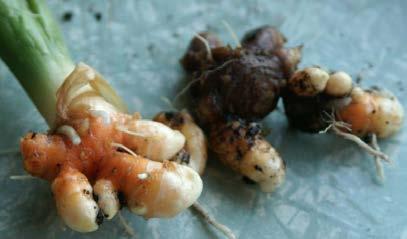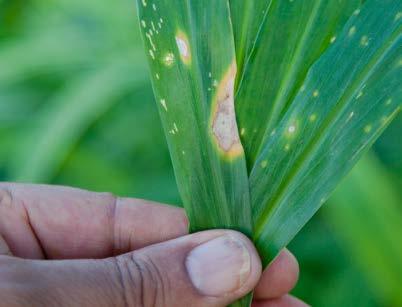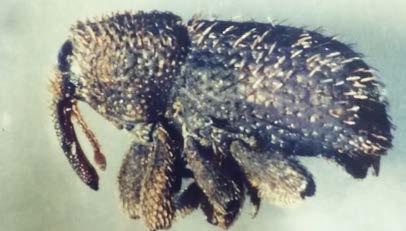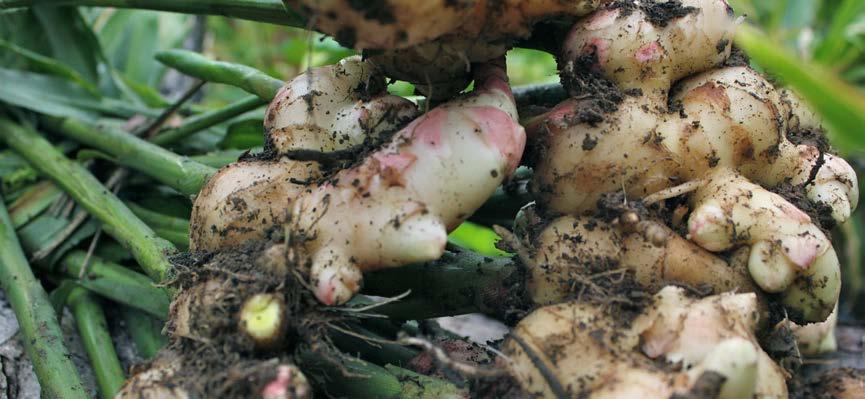
6 minute read
Disease & Pest Management
Continuous cropping of the same land is a common practice in Jamaica. This, combined with the use of planting material saved from the previous year, has contributed to the build-up of a number of diseaseproducing organisms, which have become destructive in many areas.
The main pathogens associated with this disease are the fungus Fusarium spp. and the root knot nematode Meloidogyne sp.. Occasionally, the fungi Rhizoctonia solani, and Pythium sp., along with the bacterium Pseudomonas sp. have been isolated from diseased rhizomes.
Advertisement
Fusarium Yellows and Rhizome Rot
Fusarium Yellows and Rhizome Rot is a major disease of economic importance to ginger production in Jamaica. It has been found in most commercial plantings on the island. Plants infected by the fungus Fusarium oxysporum f. zingiberi do not wilt as rapidly as those affected by bacterial wilt. Instead, infected ginger plants are stunted and yellow. The lower leaves dry out over an extended period of time (fig). It is common to find yellow, stunted above-ground shoots among apparently healthy green shoots. The plant finally dries out as the fungus invades the entire vascular system of the underground rhizomes.
Infected rhizomes show a creamy brown discoloration in the water-conducting portion of the rhizome, and a prominent black dry rot of the tissues of the cortex. The rhizomes do not become soft and water-soaked.
The disease may start in the seed piece originally planted, although it has been observed that the fungus can readily invade wounded healthy seed planted in infested soil as well. As the rot advances into newer rhizome sections, the cortex shows sunken areas. This is especially noticeable on infected rhizomes in storage.
The fungus can be carried in infected rhizomes. The fungus also produces resting structures in the decomposing tissues of infected rhizomes. Therefore, tissues from infected crops remaining in the field serve as a reservoir of the fungus. Once a ginger field becomes infected, the fungus can remain in the soil for many years. While this may not be clearly noticeable in the rhizome at harvest, ginger harvested from fields contaminated with the Fusarium Yellows fungus may be infected, allowing the fungus to continue to destroy the rhizome tissues in storage. This is a dry rot characterized by collapse of the cortical tissues, occasionally accompanied by a purpling of the infected areas of the rhizome, and a white, cottony mycelial growth on the cut surfaces of ginger pieces. It is recommended that rhizomes from infected fields should not be used as planting material. the extensive bacterial ooze that appears as a creamy slime on the surface of a cut made in the rhizome or on the above-ground stem of an infected plant. The bacterial wilt of ginger is caused by a strain of Ralstonia solanacearum. The strain of the bacteria attacking ginger will weakly attack tomato, pepper, and eggplant. There is a possibility however that under field conditions, the tomato strain could be severe on ginger, and the ginger strain severe on crops belonging to the tomato family. Thus, it is highly undesirable to plant either crop in a field in which the other had been diseased. The bacterium that causes this disease is soil-borne, and also may be carried in infected rhizomes. Usually, bacterial wilt can be spread from diseased to healthy rhizomes with the knife used to cut the rhizomes into seed pieces. New soil can be contaminated with the bacteria by use of contaminated farm equipment, or by irrigation water flowing through infested soil.


Bacterial Wilt
Bacterial wilt of ginger is a very destructive disease, and has been reported from some commercial gingergrowing areas of Jamaica. The first symptoms of wilt are a slight yellowing and wilting of the lower leaves. The wilt progresses upward, affecting the younger leaves, followed by a complete yellowing and browning of the entire shoot. Under conditions favourable for disease development, the entire shoot becomes limp and wilts with little or no visible yellowing. However, the plant dries very rapidly and the foliage becomes yellowbrown in 3 to 4 days. Young succulent shoots frequently become soft and completely rotted, and these diseased shoots break off easily from the underground rhizome at the soil line. The underground parts are also completely infected. Greyish-brown discoloration of the rhizomes may be localized if the disease is at an early stage of infection, or discoloration may be general if the disease is in an advanced stage. A water-soaked appearance of the central part of the rhizome is common. In advanced infections, the entire rhizome becomes soft and rots (Fig 7). Bacterial wilt of ginger can be distinguished from other rhizome rots of ginger by the condition of the rhizome and the foliage. A better diagnostic feature is
Nematodes
Ginger rhizomes can be severely infected with Meloidogyne incognita, the root-knot nematode. The nematode affects the market quality of the crop very seriously, but normally does not destroy the rhizomes. Prominent surface galls are not formed in ginger rhizomes as it does in other plants, and in ginger, the external symptoms are usually not observed. In severe infections, the cortex of the rhizomes appears somewhat lumpy and cracked with water-soaked, slightly brown lesions (Fig.13). Mature females of the nematode are found in these lesions. These water-soaked areas below the epidermis of the rhizomes can be quite numerous in severely infected rhizomes. The nematode lesions can serve as points of entry to common bacteria and fungi, which are otherwise unable to invade uninjured tissues, and the rhizomes may be destroyed in storage by such organisms.
Leaf Spots

Leaf Spot (Fig 15), caused by the fungus Phyllosticta spp., is a minor disease that can cause significant economic losses if not properly managed. In recent years, there has been an increase in the incidence of this disease consistent with the expansion of production and increases in rainfall events. It can cause severe losses if foliage is affected early in the crop. The disease is noticed on the leaves from July to October. The disease starts as a water-soaked spot which later turns into a white spot surrounded by dark brown margins and yellow halo. The lesions enlarge and adjacent lesions coalesce to form necrotic areas. The disease spreads through rain splashes during intermittent showers. The incidence of the disease is severe in ginger grown under exposed conditions. Leaves may eventually die. Fungicides containing Mancozeb provide good control.
Pythium Soft Rot
Pythium sp has been reported as a cause of severe soft rot of ginger in the field. The fungus has been reported to be carried in seed pieces. In Jamaica, this fungus has been isolated from ginger rhizomes showing soft rot. It is possible that under high rainfall and on poorly drained soil, Pythium soft rot of ginger could be a concern. The yellowing shown by the affected plants can be confused with symptoms of Fusarium yellows and with other problems such as mineral deficiencies. The soft rot caused by Pythium does not produce offensive odours, which are characteristic of some bacterial rots.

Rhizome Scale
Rhizome scale, or turmeric root scale (Aspidiella hartii), is an underground pest of the rhizome. It damages the rhizome by sucking sap from the developing rhizome buds; as a result, the quality of infested rhizomes in storage will deteriorate, affecting storage life and marketability. Infested planting material will have poor germination. Infestations are usually observed during the dry season. When infestations are severe, the sprouting of the ginger is severely affected. Adult females are minute in size (1.5 mm in diameter), circular, and light brown to grey in colour. Females reproduce sexually and asexually. Timely harvesting and discarding of infested rhizomes during storage reduces further spread of the pest infestation in storage. predisposes rhizomes to storage rots and affects the marketable quality of the rhizomes.
Control of pests and diseases
To prevent pests and diseases, several things must be done.
Weevils
The yam weevil (Paleopus costicollis) is considered a pest of quarantine importance. While not known to cause economic damage at the field level, it can be a troublesome storage pest. Financial losses can be incurred if rejections occur due to interception on ginger exports. The adult female is 3.9 mm long and 1.90 mm wide, while the male is 3.6 mm long and 1.8 mm wide. The body is uniform dull black, while the appendages are reddish brown. The eggs are deposited under the skin of the rhizomes where the larvae emerge. The larval stage has four instars with a sclerotized brown head and white body, which progressively becomes yellow at each instar. The pupa is 3.2 – 4.9 mm long and 1.8–2.5 m wide. The pupa is a typical exarate coleopterous type i.e. pupating without being enclosed in a cocoon. The life cycle is completed within the rhizome. Both adults and larvae feed on the internal tissues by tunnelling. The presence of the weevil can be detected by fine droppings (frass) and exit holes. Damage by the weevil

Do not use planting material from infected fields
Select only healthy-looking rhizomes from healthylooking plants
Obtain clean planting material from select nurseries
Break and inspect inside of rhizomes for off-colour, rot, and nematode lesions.
Avoid planting on lands which have a disease history
Treat planting material before planting (see appendix A &B)
Do not grow ginger for more than two seasons in the same location to avoid build-up of pathogens

Crop rotation should be practised for three to four years in ginger production systems
The use of organic amendments in the form of composts or organic mulch will aid in the build-up of soil quality, organic matter, and microbial activity, thus assisting in suppressing soil-borne pathogens.






